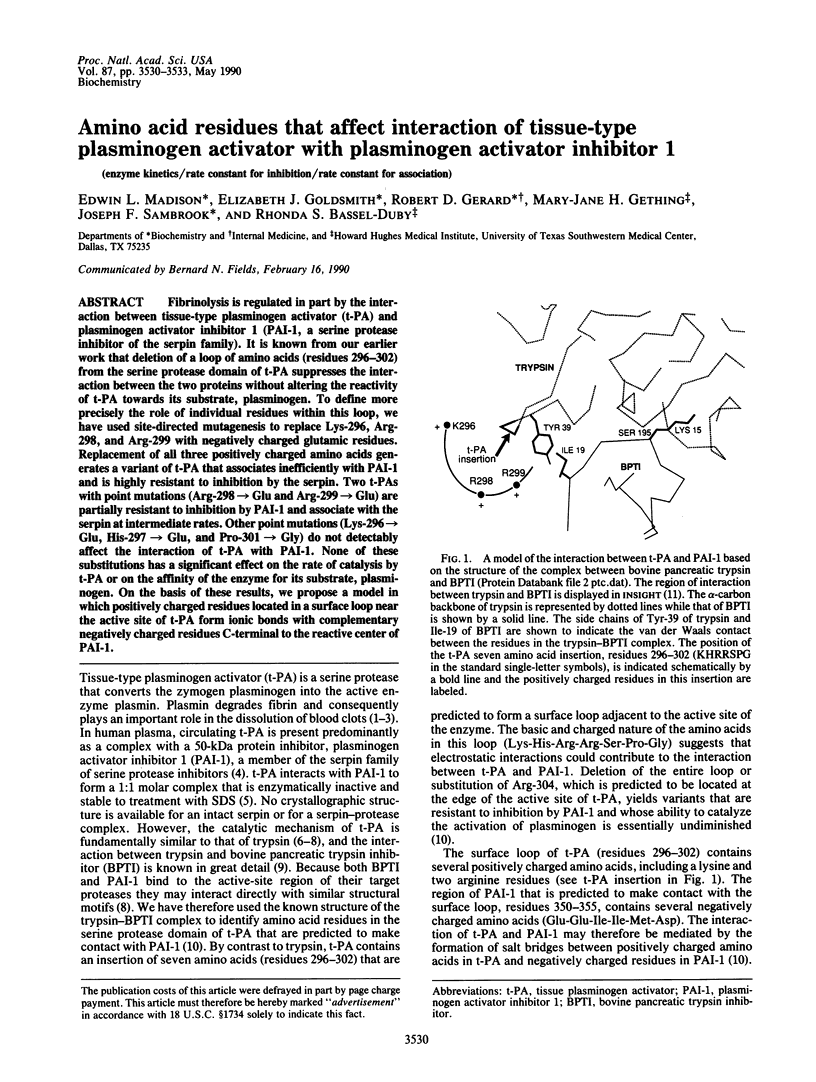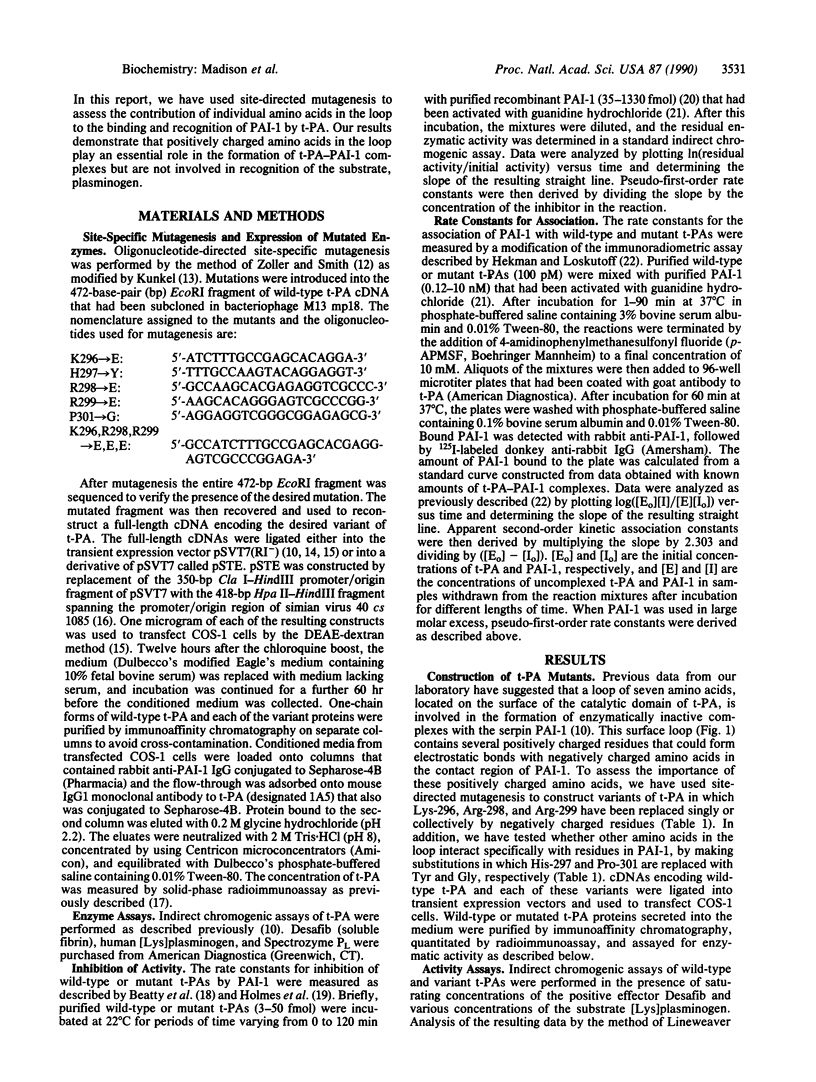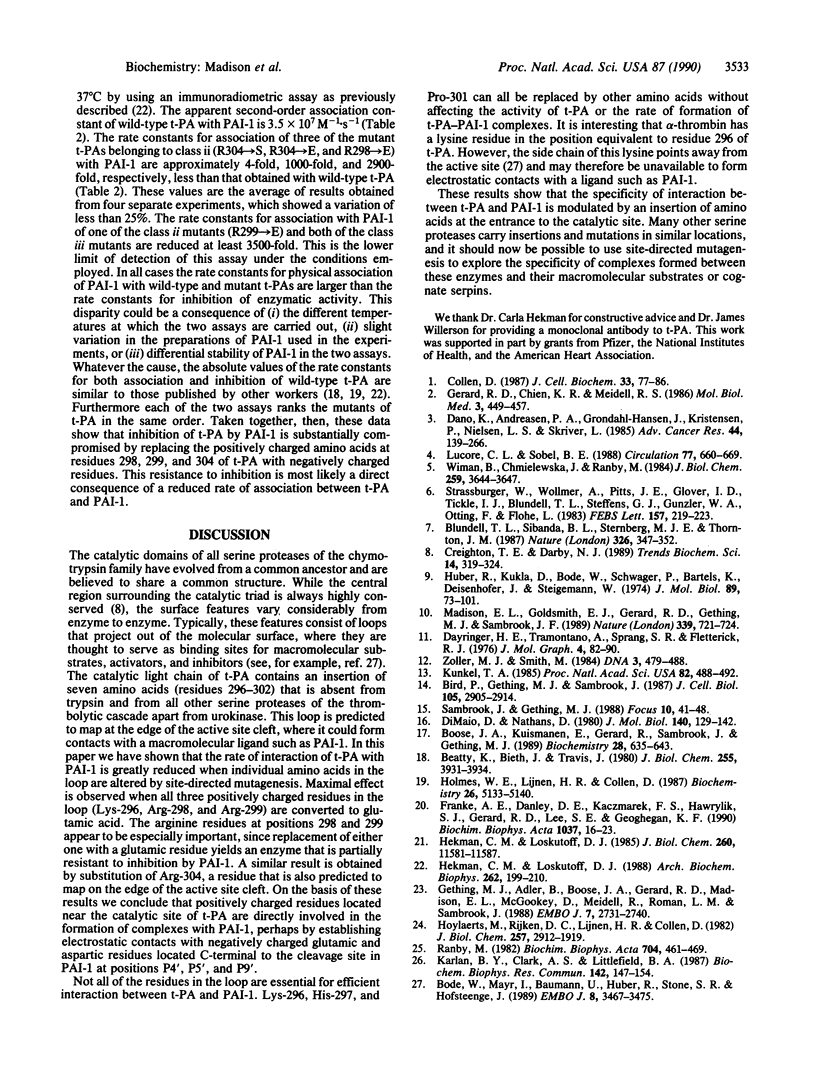Abstract
Fibrinolysis is regulated in part by the interaction between tissue-type plasminogen activator (t-PA) and plasminogen activator inhibitor 1 (PAI-1, a serine protease inhibitor of the serpin family). It is known from our earlier work that deletion of a loop of amino acids (residues 296-302) from the serine protease domain of t-PA suppresses the interaction between the two proteins without altering the reactivity of t-PA towards its substrate, plasminogen. To define more precisely the role of individual residues within this loop, we have used site-directed mutagenesis to replace Lys-296, Arg-298, and Arg-299 with negatively charged glutamic residues. Replacement of all three positively charged amino acids generates a variant of t-PA that associates inefficiently with PAI-1 and is highly resistant to inhibition by the serpin. Two t-PAs with point mutations (Arg-298----Glu and Arg-299----Glu) are partially resistant to inhibition by PAI-1 and associate with the serpin at intermediate rates. Other point mutations (Lys-296----Glu, His-297----Glu, and Pro-301----Gly) do not detectably affect the interaction of t-PA with PAI-1. None of these substitutions has a significant effect on the rate of catalysis by t-PA or on the affinity of the enzyme for its substrate, plasminogen. On the basis of these results, we propose a model in which positively charged residues located in a surface loop near the active site of t-PA form ionic bonds with complementary negatively charged residues C-terminal to the reactive center of PAI-1.
Full text
PDF



Selected References
These references are in PubMed. This may not be the complete list of references from this article.
- Beatty K., Bieth J., Travis J. Kinetics of association of serine proteinases with native and oxidized alpha-1-proteinase inhibitor and alpha-1-antichymotrypsin. J Biol Chem. 1980 May 10;255(9):3931–3934. [PubMed] [Google Scholar]
- Bird P., Gething M. J., Sambrook J. Translocation in yeast and mammalian cells: not all signal sequences are functionally equivalent. J Cell Biol. 1987 Dec;105(6 Pt 2):2905–2914. doi: 10.1083/jcb.105.6.2905. [DOI] [PMC free article] [PubMed] [Google Scholar]
- Blundell T. L., Sibanda B. L., Sternberg M. J., Thornton J. M. Knowledge-based prediction of protein structures and the design of novel molecules. 1987 Mar 26-Apr 1Nature. 326(6111):347–352. doi: 10.1038/326347a0. [DOI] [PubMed] [Google Scholar]
- Bode W., Mayr I., Baumann U., Huber R., Stone S. R., Hofsteenge J. The refined 1.9 A crystal structure of human alpha-thrombin: interaction with D-Phe-Pro-Arg chloromethylketone and significance of the Tyr-Pro-Pro-Trp insertion segment. EMBO J. 1989 Nov;8(11):3467–3475. doi: 10.1002/j.1460-2075.1989.tb08511.x. [DOI] [PMC free article] [PubMed] [Google Scholar]
- Boose J. A., Kuismanen E., Gerard R., Sambrook J., Gething M. J. The single-chain form of tissue-type plasminogen activator has catalytic activity: studies with a mutant enzyme that lacks the cleavage site. Biochemistry. 1989 Jan 24;28(2):635–643. doi: 10.1021/bi00428a033. [DOI] [PubMed] [Google Scholar]
- Collen D. Molecular mechanisms of fibrinolysis and their application to fibrin-specific thrombolytic therapy. J Cell Biochem. 1987 Feb;33(2):77–86. doi: 10.1002/jcb.240330202. [DOI] [PubMed] [Google Scholar]
- Creighton T. E., Darby N. J. Functional evolutionary divergence of proteolytic enzymes and their inhibitors. Trends Biochem Sci. 1989 Aug;14(8):319–324. doi: 10.1016/0968-0004(89)90159-x. [DOI] [PubMed] [Google Scholar]
- Danø K., Andreasen P. A., Grøndahl-Hansen J., Kristensen P., Nielsen L. S., Skriver L. Plasminogen activators, tissue degradation, and cancer. Adv Cancer Res. 1985;44:139–266. doi: 10.1016/s0065-230x(08)60028-7. [DOI] [PubMed] [Google Scholar]
- DiMaio D., Nathans D. Cold-sensitive regulatory mutants of simian virus 40. J Mol Biol. 1980 Jun 15;140(1):129–142. doi: 10.1016/0022-2836(80)90359-9. [DOI] [PubMed] [Google Scholar]
- Franke A. E., Danley D. E., Kaczmarek F. S., Hawrylik S. J., Gerard R. D., Lee S. E., Geoghegan K. F. Expression of human plasminogen activator inhibitor type-1 (PAI-1) in Escherichia coli as a soluble protein comprised of active and latent forms. Isolation and crystallization of latent PAI-1. Biochim Biophys Acta. 1990 Jan 19;1037(1):16–23. doi: 10.1016/0167-4838(90)90096-x. [DOI] [PubMed] [Google Scholar]
- Gerard R. D., Chien K. R., Meidell R. S. Molecular biology of tissue plasminogen activator and endogenous inhibitors. Mol Biol Med. 1986 Dec;3(6):449–457. [PubMed] [Google Scholar]
- Gething M. J., Adler B., Boose J. A., Gerard R. D., Madison E. L., McGookey D., Meidell R. S., Roman L. M., Sambrook J. Variants of human tissue-type plasminogen activator that lack specific structural domains of the heavy chain. EMBO J. 1988 Sep;7(9):2731–2740. doi: 10.1002/j.1460-2075.1988.tb03127.x. [DOI] [PMC free article] [PubMed] [Google Scholar]
- Hekman C. M., Loskutoff D. J. Endothelial cells produce a latent inhibitor of plasminogen activators that can be activated by denaturants. J Biol Chem. 1985 Sep 25;260(21):11581–11587. [PubMed] [Google Scholar]
- Hekman C. M., Loskutoff D. J. Kinetic analysis of the interactions between plasminogen activator inhibitor 1 and both urokinase and tissue plasminogen activator. Arch Biochem Biophys. 1988 Apr;262(1):199–210. doi: 10.1016/0003-9861(88)90182-8. [DOI] [PubMed] [Google Scholar]
- Holmes W. E., Lijnen H. R., Collen D. Characterization of recombinant human alpha 2-antiplasmin and of mutants obtained by site-directed mutagenesis of the reactive site. Biochemistry. 1987 Aug 11;26(16):5133–5140. doi: 10.1021/bi00390a036. [DOI] [PubMed] [Google Scholar]
- Hoylaerts M., Rijken D. C., Lijnen H. R., Collen D. Kinetics of the activation of plasminogen by human tissue plasminogen activator. Role of fibrin. J Biol Chem. 1982 Mar 25;257(6):2912–2919. [PubMed] [Google Scholar]
- Huber R., Kukla D., Bode W., Schwager P., Bartels K., Deisenhofer J., Steigemann W. Structure of the complex formed by bovine trypsin and bovine pancreatic trypsin inhibitor. II. Crystallographic refinement at 1.9 A resolution. J Mol Biol. 1974 Oct 15;89(1):73–101. doi: 10.1016/0022-2836(74)90163-6. [DOI] [PubMed] [Google Scholar]
- Karlan B. Y., Clark A. S., Littlefield B. A. A highly sensitive chromogenic microtiter plate assay for plasminogen activators which quantitatively discriminates between the urokinase and tissue-type activators. Biochem Biophys Res Commun. 1987 Jan 15;142(1):147–154. doi: 10.1016/0006-291x(87)90463-3. [DOI] [PubMed] [Google Scholar]
- Kunkel T. A. Rapid and efficient site-specific mutagenesis without phenotypic selection. Proc Natl Acad Sci U S A. 1985 Jan;82(2):488–492. doi: 10.1073/pnas.82.2.488. [DOI] [PMC free article] [PubMed] [Google Scholar]
- Lucore C. L., Sobel B. E. Interactions of tissue-type plasminogen activator with plasma inhibitors and their pharmacologic implications. Circulation. 1988 Mar;77(3):660–669. doi: 10.1161/01.cir.77.3.660. [DOI] [PubMed] [Google Scholar]
- Madison E. L., Goldsmith E. J., Gerard R. D., Gething M. J., Sambrook J. F. Serpin-resistant mutants of human tissue-type plasminogen activator. Nature. 1989 Jun 29;339(6227):721–724. doi: 10.1038/339721a0. [DOI] [PubMed] [Google Scholar]
- Rånby M. Studies on the kinetics of plasminogen activation by tissue plasminogen activator. Biochim Biophys Acta. 1982 Jun 24;704(3):461–469. doi: 10.1016/0167-4838(82)90068-1. [DOI] [PubMed] [Google Scholar]
- Strassburger W., Wollmer A., Pitts J. E., Glover I. D., Tickle I. J., Blundell T. L., Steffens G. J., Günzler W. A., Otting F., Flohé L. Adaptation of plasminogen activator sequences to known protease structures. FEBS Lett. 1983 Jul 4;157(2):219–223. doi: 10.1016/0014-5793(83)80551-1. [DOI] [PubMed] [Google Scholar]
- Wiman B., Chmielewska J., Rånby M. Inactivation of tissue plasminogen activator in plasma. Demonstration of a complex with a new rapid inhibitor. J Biol Chem. 1984 Mar 25;259(6):3644–3647. [PubMed] [Google Scholar]
- Zoller M. J., Smith M. Oligonucleotide-directed mutagenesis: a simple method using two oligonucleotide primers and a single-stranded DNA template. DNA. 1984 Dec;3(6):479–488. doi: 10.1089/dna.1.1984.3.479. [DOI] [PubMed] [Google Scholar]


